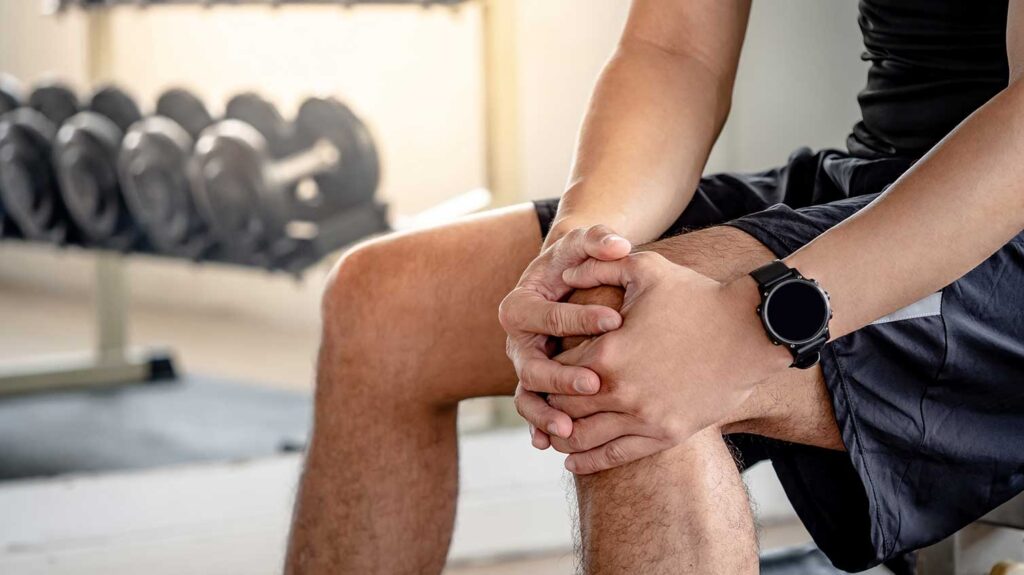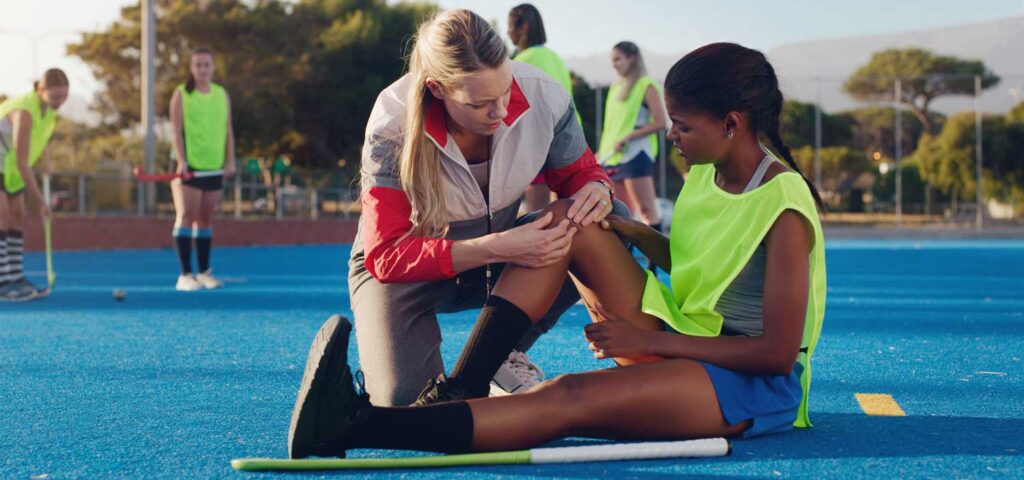According to the British Journal of Sports Medicine, knee injuries account for around 41% of all sports injuries. Knee injuries can typically be divided into two categories: traumatic and overuse. Examples of traumatic injuries include things like ACL tears, whereas overuse injuries include pathologies such as patellar tendinopathy or jumper’s knee. This blog will cover common traumatic and overuse injuries and how physical therapy can help treat or prevent them.
Traumatic Knee Injuries in Athletes: Contact & Non-Contact
Traumatic injuries occur due to an acute event, such as a collision, fall, or awkward landing, resulting in sudden tissue damage. These injuries can be further divided into contact and non-contact, each with distinct mechanisms and some overlap. Both types of traumatic knee injuries can result in significant downtime and may require surgical intervention or extensive rehabilitation, depending on the severity. Early diagnosis and appropriate management are crucial for optimal recovery and return to sport.
What Are Different Types of Traumatic Contact Knee Injuries

These occur due to an external force, such as a blow to the knee during a tackle or a collision with another player or the ground. Examples:
Medial Collateral Ligament (MCL) Tear
Tears from lateral impacts, such as being tackled from the side or colliding with another player, cause the knee to buckle inward.
Meniscus Tear (Contact-related)
Tears from a twisting force combined with a direct hit to the knee are often seen during tackles or falls.
Patellar Dislocation (Contact-related)
Occurs when a lateral force pushes the kneecap out of its groove, such as during a direct blow to the side of the knee.
Posterior Cruciate Ligament (PCL) Tear
Tears from direct trauma to the front of a knee are commonly seen in collisions or falls onto a flexed knee. This is often seen in football when a player is tackled low, forcing their knee backward while falling forward.
Bone Bruise
Occurs from an impact force strong enough to compress the bone, such as during a hard tackle or fall, without causing a full fracture. This can happen in hockey when players are slammed against the boards or after sliding into another player or goalpost.
Patellar Fracture
Fractures caused by a direct hit or fall onto the kneecap are often seen in high-impact sports. Examples include falling directly onto the knee during skateboarding or after a failed landing in gymnastics.
Lateral Collateral Ligament (LCL) Tear
Tears from medial impacts, such as a direct blow to the inner knee that pushes it outward.
Tibial Plateau Fracture
Fracture at the top of the tibia from forceful axial loading, such as falling from a height or a collision that drives the femur into the tibia. It is common in sports like skiing, where awkward landings or crashes apply extreme force to the knee.
What Are Different Types of Traumatic Non-Contact Knee Injuries
These happen without any external force and are typically caused by sudden movements, such as pivoting, cutting, or improper landings. Examples:
Anterior Cruciate Ligament (ACL) Tear
Tears caused by sudden deceleration, pivoting, or awkward landings are commonly seen in sports like basketball, soccer, and volleyball during rapid direction changes or after jumping.
Medial Collateral Ligament (MCL) Sprain
Non-contact sprains can occur due to poor balance or improper landing mechanics, causing valgus stress on the knee, often seen in cutting sports like soccer and basketball.
Patellar Dislocation (Non-Contact)
It occurs when the kneecap slips out of its groove due to an awkward landing or sharp change in direction without external contact. Common in sports like basketball and gymnastics.
Meniscus Tear (Non-Contact)
Tears occur when the knee twists during a sudden pivot or directional change without contact, often in soccer or basketball.
Posterior Cruciate Ligament (PCL) Tear
This tear occurs when the knee hyperextends, or a sudden force pushes the shin backward during a non-contact motion, common in knee hyperextensions or awkward landings.
Hamstring Strain
Occurs suddenly due to a forceful, eccentric contraction of the hamstring, often during high-speed running, sprinting, or sudden deceleration
What Are The Types of Non-Traumatic (Overuse) Knee Injuries

These injuries develop gradually due to repetitive stress, improper biomechanics, poor load volume management, or insufficient recovery. They often begin as minor pain or discomfort that worsens over time. Examples:
Patellar Tendinopathy (Jumper’s Knee)
Degeneration of the patellar tendon, caused by repetitive jumping, squatting, or high-impact activities, is common in basketball and volleyball.
Patellofemoral Pain Syndrome (Runner’s Knee)
Anterior knee pain is caused by poor patellar tracking, muscle imbalances, or overuse during running, squatting, or other dynamic movements.
Quadriceps Tendinopathy
Chronic overuse of the quadriceps tendon at the top of the patella is commonly seen in sports requiring repeated sprinting, jumping, or deep squatting.
Osgood-Schlatter Disease
Inflammation at the patellar tendon attachment to the tibial tuberosity is typically seen during an adolescent athlete’s growth spurt. Typically, those involved in running and jumping sports experience Osgood-Schlatter Disease.
How Physical Therapy Can Treat Knee Injuries
Physical therapy plays a crucial role in treating and preventing knee injuries. For traumatic injuries, such as ACL or meniscus tears, physical therapists develop individualized rehabilitation plans to restore range of motion, build strength, and improve neuromuscular control. Post-surgical patients benefit from progressive exercise programs designed to return them to sport-specific activities while reducing reinjury risk safely.
In the case of non-contact injuries, such as sprains or dislocations, physical therapists focus on identifying underlying factors such as poor movement mechanics, muscle imbalances, and flexibility deficits. Treatment often includes targeted strength training, balance drills, and proprioception retraining to optimize knee stability and reduce compensatory patterns.
For overuse injuries like patellar tendinopathy or runner’s knee, PTs use pain management modalities such as soft tissue mobilization & dry needling, load management strategies, and gradual return-to-sport programs to alleviate pain and address contributing factors. Education on proper training volume and recovery techniques make a significant difference in long-term outcomes.
Preventing Knee Injuries with Physical Therapy
In addition to treatment, physical therapists implement injury prevention programs that include strength training, plyometric training, agility drills, and sport-specific exercises designed to improve landing mechanics, proprioception, and knee joint resilience. Studies have shown that implementing targeted exercises into a sports program can reduce the risk of injury.

If you’re an athlete who experiences repetitive knee pain or recently has suffered a traumatic injury, seeking treatment from a qualified physical therapist is essential for adequate recovery. Regular sessions with a physical therapist can get you back on the court faster, improve your mobility, reduce pain, and enhance your overall quality of life. Take the first step towards recovery by finding a physical therapy location near you. Early intervention can lead to quicker and more effective relief, allowing you to return to normal activities and get back to what you love.

